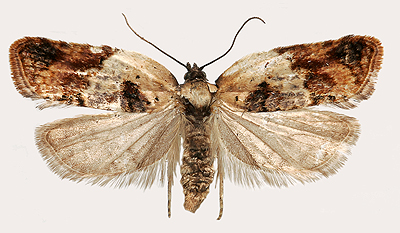Pests
Acleris variegana (Denis & Shiffermuller) - Garden Rose Tortrix.
Taxonomic position.
Class Insecta, order Lepidoptera, family Tortricidae, subfamily Tortricinae, tribe Tortricini, genus Acleris.Synonyms.
Peronea variegana (Den. et Schiff.), Acalla variegana (Den. et Schiff.).Biological group.
Polyphagous pest of rosaceous fruit trees and bushes.Morphology and biology.
Forewing of moth is parallel-sided with oblique external margin (wingspan 14-20 mm). Basal half white or yellowish-white; grayish-brown triangular spot close to wing root with a bundle of erect scales. Distal part of wing is reddish-brown or violet-brown, with narrow grayish-yellow strip. Hind wings brownish-gray. Egg are oval, light yellow (summer generation), milky-white or orange (wintering eggs). Caterpillar is yellowish or chartreuse with shiny brown head. Prothoracic scutum and forelegs brown, abdominal legs with two-level circlet of 35-57 claws. Pupa 8-9 mm long, dark brown, with large tergal spines; cremaster short, gradually thinning; appears as parallel-sided lobe bent ventrally, with unguiculate processes at corners and 6 hooked setae located in a row between the processes. Eggs overwinter. Hatching caterpillars of spring generation eat away contents of fruit buds. Later they form leaf bundles with the help of web threads; damage buds, flowers, ovaries, and unripe fruits, and skeletonize young leaves; pupate in feeding places. Average fertility is 200 eggs. Moths of summer generation lay eggs one by one or in small batches (3-6 eggs in a batch) on the lower and upper side of leaves, petioles, and shoots; wintering eggs are located on branches near fruit buds. Period of embryonic development lasts 8-11 days. Pupation occurs in places of feeding. The pupal stage lasts 11-22 days on average.Distribution.
Western Europe, North America, Northwest Africa, Asia Minor, Syria, Iran, Afghanistan and China. In the former USSR the species is distributed in the European part (except in the far north), Transcaucasia, Volga River Basin, Ural, Kazakhstan, Central Asia and Southwest Siberia.Ecology.
This species is monovoltine north of the Ukraine; produces 2 generations in the Ukraine (including Crimea), and in the mountains of Turkmenistan and Tajikistan; 3-4 generations in valleys of Transcaucasia and Central Asia. In the Ukraine first generation caterpillars hatch at the end of April-beginning of May during bud blossoming on fruiters (in a phase of green tops), 2nd generation caterpillars appear in July-August. Pupation occurs at the end of May and in the middle of June. In Crimea eggs and pupae develop in 8-11 days at a temperature of 20°C and relative air humidity of 45%; at 13.5°C and 93% humidity they develop in twice as much time. In Ukraine moth flight begins at the end of May and lasts until the end of July, then again from the middle of August until October.Economic significance.
The species is a significant pest of rosaceous fruit plants, especially of apple, pear, plum, sloe, apricot. Caterpillars also cause damage to quince, cherry, hawthorn, almonds, cotoneaster, bird cherry. They have been documented on hazel, oak, elm, willow, and berry bushes of the genus Vaccinium. Mainly the first generation caterpillars cause harm.Control measures.
Agronomic measures include pruning old and diseased branches. Biological measures include application of biological preparations. Chemical measures include local insecticide treatments during development of first generation caterpillars before flowering of pome trees (in red bud phase) immediately after flowering of stone cultures in spring, and during development of 2nd generation caterpillars in mid-July. Monitoring and forecast are possible with the use of pheromone traps.Reference citations:
Galetenko S.M. 1964. To morphology of fruit leafrollers. In: Kochkin M.A., Rubtsov N.I., Ryndin N.V., eds. 150 years to State Nikitskii botanical garden. Collection of scientific works. V. 37. Moscow: Kolos. 531-395 p. (in Russian).Kostyuk Yu.A. 1974. Family Tortricidae. In: Vasil.ev, V.P., ed. Pests of agricultural crops and forest plantations. V. 2. Arthropods. Kiev: Urozhai. 261-320 p. (in Russian).
Kostyuk Yu.A. 1980. Tortricidae. Issue 10. Tortricinae. In: Dolin V.G., ed. Fauna of Ukraine. V. 15. Kiev: Naukova dumka. 424 p. (in Ukrainian).
Kuznetsov V.I. 1994. Family Tortricidae. In: Kuznetsov V.I., ed. Insects and mites . pests of agricultural plants. V. 3(1). Lepidoptera. St. Petersburg: Nauka. 51-234 p. (in Russian).
Vasil.ev V.P., Livshits I.Z. 1984. Pests of fruit crops. Moscow: Kolos. 399 p. (in Russian).


